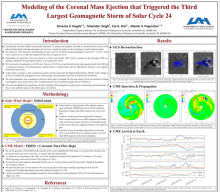Modeling of the Coronal Mass Ejection that Triggered the Third-Largest Geomagnetic Storm of Solar Cycle 24
Dinesha
Hegde
Department of Space Science & Center for Space Plasma and Aeronomic Research (CSPAR), University of Alabama in Huntsville, Huntsville, AL 35899 USA
Poster
Coronal mass ejections (CMEs) are powerful explosions on the Sun that can have a significant impact on the interplanetary medium and our planet. On August 26, 2018, during the declining phase of solar cycle 24, the third-strongest geomagnetic storm of the cycle occurred due to a CME that erupted from the Sun on August 20, 2018. Remarkably, this particular event was caused by a slower and smaller CME, which is unusual as fast and large CMEs are typically responsible for geomagnetic storms. Previous studies had reported that the flux rope associated with this CME had a complicated rotation in the interplanetary medium before it reached Earth, and the high-density structure in the magnetic cloud observed at Earth. In this study, we employ a constant-turn flux rope-based magnetohydrodynamic model to simulate the propagation of this CME through a time-dependent, data-driven ambient solar wind (SW). We utilize parameters from a graduated cylindrical shell model to constrain the flux rope model, which was obtained by fitting coronagraphic observations of the CME, including data from the Heliospheric Imager (HI) on STEREO-A. Our research highlights the significance of modeling CME propagation to gain a better understanding of the dynamics of these events and their impact on the Earth's space environment.

Poster PDF
Poster category
Solar and Interplanetary Research and Applications
Meeting homepage